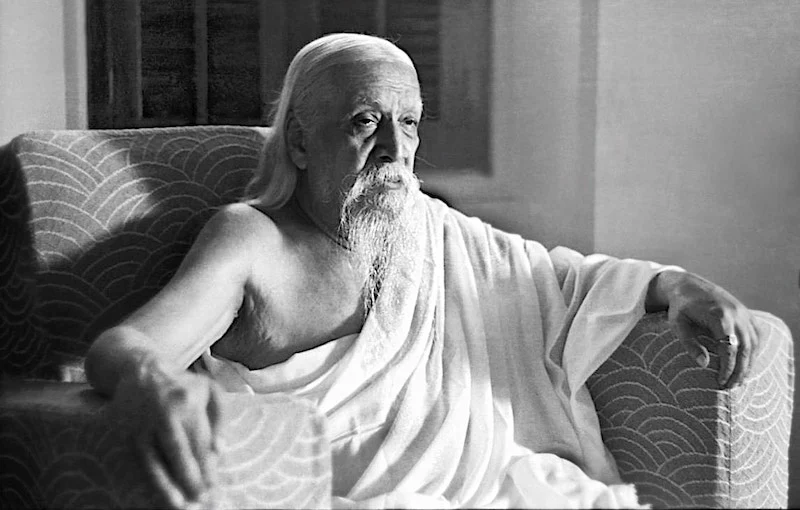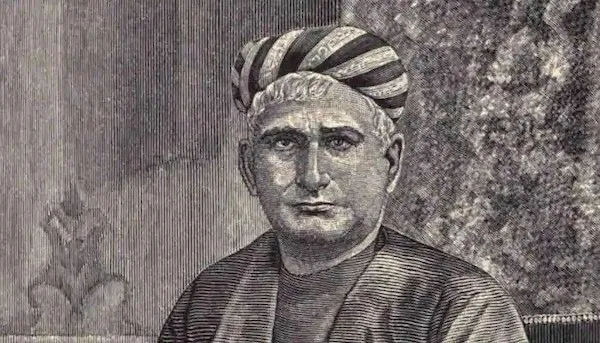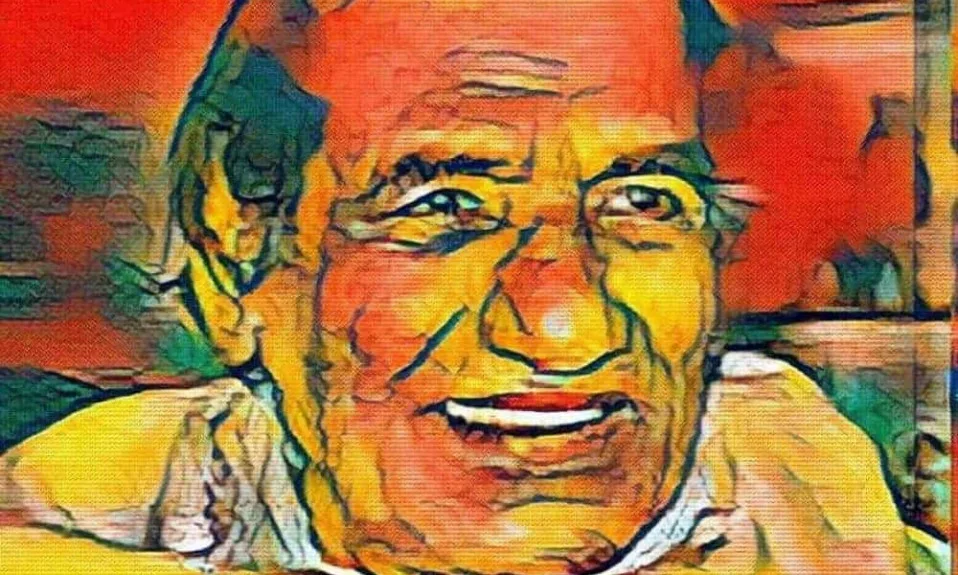Sita Ram Goel was an intellectual giant in Post Colonial India. As a first-rate thinker and writer, he produced a vast range of works in history, and philosophy, which brought the focus of Indian intellectual activity back to the pursuit of truth.
Here we discuss his journey of being born a Hindu, becoming a Marxist and a militant atheist, friendship with another intellectual giant Ram Swarup, his pursuit of truth, and after meticulously studying various ideologies and philosophies, finally becoming a Hindu again.
Initial days of Sita Ram Goel
Sita Ram Goel was born to a Hindu family in Punjab in 1921, though he spent his childhood in Calcutta.
He grew up reading Mahabharata and developed a great admiration for Lord Krishna. Sri Garibdas, Arya Samaj, Mahatma Gandhi, Sri Ramakrishna, and Swami Vivekananda also significantly influenced his life.
But the harsh and ugly reality around him, occasioned by the cruelty, oppression, high-handedness, and injustice, made him question if there was a moral order in the universe at large and in human society.
He met great people at critical junctures in his life who profoundly influenced him in many ways. One of them was his philosopher friend, who introduced him to various systems of Western philosophy.
Another one was his Sanskrit professor, who was the reason behind his everlasting love for Sanskrit language and literature and changed his way of looking at Hindu philosophy and history.
Sita Ram Goel’s journey of becoming a Marxist Atheist
In the meantime, he got interested in Socialism after a controversy broke out between Mahatma Gandhi and Subhash Chandra Bose regarding the same. From Socialism, he moved to Communism after reading the “Communist Manifesto” and two volumes of “Das Kapital” by Karl Marx. Marx’s meticulous scholarship, his razor-sharp logic for the Labour Theory of Value (LTV), and his case against capitalism impressed him. For the uninitiated, LTV is central to Marxist theory, which holds that the working class is exploited under capitalism and dissociates price and value.
According to Goel, Marx provided him with a more profound solution to moral problems.
“An individual could not be moral in the midst of an immoral society.”
From being a Marxist, he became a Communist, i.e., an admirer of the Soviet Union without even knowing about the condition of life in Soviet Russia. This ideological shift made him more interested in the affairs of the Soviet Union rather than the freedom struggle ongoing against the British in India.
At the same time, he concluded that there are three ways to conceive God:
- as a rogue who allowed and shared in the roguery prevalent in his world
- as an imbecile who has no control over his creation
- or as a recluse who did not care about his creation
He said,
“If God was a rogue, we had to rise in revolt against his rule. If he was an imbecile, we could forget him and take charge of the world ourselves. And if he was a recluse, he could mind his business while we minded our own.”
But even after becoming a Marxist and then a Communist, he didn’t accept Marxism completely.
His issues with Marxism
He took Marx’s Historical Materialism as an adequate explanation of the processes of human history, his Labour Theory of Value as the source of all capital accumulated by human society, and that the State was an instrument of class oppression.
But he could not accept Dialectical Materialism as a valid view of the world process. The reason is that Materialism was deterministic in nature and on the contrary, Dialectics has an obvious element of teleology within it. Therefore, Materialism and Dialectics were logically irreconcilable.
This ideological gap continued to rankle in his mind.
His meeting with Ram Swarup
 |
| Sita Ram Goel (left) and Ram Swarup (right) |
In the meantime, he met Ram Swarup, his senior by one year in the same college. They became friends immediately and started meeting regularly, discussing a variety of topics.
Swarup’s view on Marxism
While discussing Marxism, Swarup agreed with Marx’s theory regarding the role of class conflict in human history. But he raised two vital questions:
- How did classes come to be constituted in the first instance?
- How did the haves manage to appropriate the means of production?
According to Marx, “classes had arisen in the primitive communist society when the means of production got accumulated, and some people appropriated them to the disadvantage of others. The owners of these means became the haves who now started lording it over the have nots.”
But according to Swarup, “classes were the outcome of national conflicts in which one group of people conquered and imposed itself on another group and misappropriated the means of production.”
For him, national conflicts had primacy over class conflicts. For example, during India’s Independence struggle, the national conflict with British colonialism had primacy over whatever class conflicts were present in Indian society. This way, he uses the Marxian concept to outflank Marx.
Sita Ram Goel and Communist Party of India
While working as a senior executive in Calcutta, Goel met a young broker who was also a member of the Communist Party of India. The broker introduced him to various Communist front organizations like the Indian People’s Theatre Association and Progressive Writers Association.
Party members told him about the heroic tales of other communists, which out of sheer ignorance, he believed. But later on, he realizes that it was mostly Communist propaganda meant for the consumption of party comrades.
His disillusionment with Communism & Marxism
He was heading full steam into Communism, but suddenly he received a severe jolt. It was a novel by Aldous Huxley; “Time Must Have A Stop.” The writer’s demolition of the dogma of inevitable progress, which was the bedrock of all Western thought, including Marxism, broke his Marxist spell.
He concluded that,
“The roots of social evils lay ultimately in human nature itself. A desirable order could not be built out of the desired soul of man.”
But even after receiving a severe jolt, he attended the Second Party Conference of the Communist Party of India in Calcutta in February 1948. He was thrilled and made up his mind to join the Party immediately. He conveyed his decision to his friend Ram Swarup.
Swarup wrote back immediately to Goel,
“You are too intelligent not to become a Communist. But you are also too intelligent to remain one for long.”
It is after this remark that Goel’s journey of renouncing Communism begins. Destiny also helped Goel in that. The day he was going to join the Party, the Communist Party in Bengal was banned precisely on the same date.
Moreover, Ram Swarup suddenly appeared on the scene and expressed his intention to stay with him for quite some time. Swarup decimated all the arguments of his Communist friends one by one.
 |
| Source: Welt |
After this, he read “Stalin’s Russia” by Suzanne Labin, and “I Chose Freedom” by Victor Kravchenko, which destroyed Communist propaganda of a utopian society.
Goel concluded that the premises of Marxism and Western Capitalism are not much different. Both were based on:
- materialist worldview
- evolutionistic sociology
- hedonistic psychology
- practical ethics
- consumerist economy
The Communist Soviet Union uses State Capitalism with systematic terror, while the capitalist United States uses the remorseless operation of market forces. In both cases, the end goal is the same, i.e., the economy of abundance.
By then, Goel has renounced Marxism as an inadequate system. He realized that the Communist Party of India was a fifth column for the advancement of Communist Russian imperialism in India and the Soviet Union was nothing more than a vast slave empire under Stalin.
Sita Ram Goel from being a Communist to Anti-Communist
Both Goel and Swarup took the task of exposing Communist propaganda which is harmful to:
- Human freedom
- National cohesion
- Social health
- Economic development
- Political and cultural pluralism
They did this by using the Communist publications, which are enough for exposing the Communist countries as totalitarian tyrannies with low standards of living and regimented culture.
Understanding how Communism works and ways to counter it
But soon, they realized that Communism uses cultural vacuum to its great advantage. It derives support from a deeper source, a new self-alienation amongst the political and cultural elite.
They needed a positive frame of reference to keep Communism at bay. But what could be that frame?
- Democracy? No, because India was already a democratic country. Communists were using the same democracy successfully towards its ultimate subversion under the garb of freedom of speech and cultural Marxism.
- Socialism? No, because India already adopted it as a state policy.
- Free Enterprise? No, because it is another word for ruthless Capitalism. In a country that has been plundered by British colonialism, people were not ready to accept it at that juncture.
Goel thought of nationalism as a potent antidote to Communism, but Swarup had a different view of that.
Swarup said,
“Foreign should not be defined in geographical terms. Then it would have no meaning except territorial or tribal patriotism. To me, that alone is foreign, which is foreign to truth, foreign to Atman.”
It touched some chord in Goel’s heart.
They withdraw their anti-communist campaign because they believed that to save the nation from the corrosion of its soul, they have to fight a more significant battle couched along deeper cultural contours.
Sita Ram Goel going back to his cultural heritage
They became more and more meditative by then, especially Ram Swarup. His discussions were centered around the Vedas, the Upanishads, the Gita, and the Mahabharata.
The true meaning of Dharma
Swarup initiated Goel into meditation. He makes him understand the true meaning of Dharma.
For Goel, Dharma was a matter of moral norms, external rules and regulations, do’s and don’ts, enforced on life by an act of will.
But Swarup made him see Dharma as a multi-dimensional movement of man’s inner law of being, psychic evolution, spiritual growth, and spontaneous building of an outer life for himself and the community in which he lived.
Impact of Sri Aurobindo, Bankim Chandra Chatterjee & Sri Ramakrishna on Sita Ram Goel
 |
| Sri Aurobindo (Source: SriAurobindoAshram) |
The one person who had the most profound impact on his life was Sri Aurobindo. The message of Sri Aurobindo was the same old Vedic message of realization of the self.Along with an exponent of Vedic spirituality, Sri Aurobindo was also a poet, a critic, a statesman, and a superb sociologist.
According to Sri Aurobindo, as described in his book, “The Human Cycle,” man’s striving for spiritual perfection in his inner and outer life is the prime mover of the world matrix.
In “The Life Divine,” Sri Aurobindo deals with the man (human being) as a soul luminous with an inherent divinity, which alone could sustain and give meaning to the outer manifestations of the human personality.
His book “Foundations of Indian Culture”, made him realize that India’s multifaceted heritage of great spirituality, art, architecture, literature, social principles, and political forms sprang from and revolved around a single center. That center was Sanatana Dharma, which was the very soul of India.
Sri Aurobindo had made it very clear in his book “Uttarpara Speech” that India rose with the rise of Sanatana Dharma and would die if Sanatana Dharma was allowed to die.
Bankim Chandra Chatterjee
 |
| Bankim Chandra Chatterjee (Source: ZeeNews) |
Another great writer who enlightened him was Bankim Chandra Chatterjee. His works made him see the horrors of modern Indology more than ever before.
Sri Ramakrishna
 |
| Sri Ramakrishna Paramahamsa (Source: Talkativeman) |
Then he read Kathamrita, the conversations and activities of Sri Ramakrishna Paramahamsa, the guru of Swami Vivekananda.
His talks embodied expressions of a concrete consciousness that had dropped every trace of the dirt and dross and inertia, which characterized what is known as normal human consciousness.
- What was the nature of the Universe?
- What was man’s place in it?
- Was there a God?
- Had he created this Cosmos?
- Why had he made such a mess of it?
- What was the goal of human life?
- Was man free to pursue that goal?
- Or was he predetermined or predestined or fated for a particular purpose by forces beyond his control? And so on.
He realizes that it was nothing more than endless chatter in his mind. It was the quality of his consciousness that controlled the quality of the questions he raised. These irrelevant questions and curiosities are blocking the way for a purer and higher consciousness.
For establishing contact with higher consciousness, the normal human consciousness had to be made passive. The best way to do this is through meditation.
Sita Ram Goel and meditation
One day he meditated on Ahimsa. Another day he meditated on Devi (Goddess) as he had never accepted Devi either as Saraswati or as Lakshmi or as Durga or as Kali earlier.
Nothing happened for some time. But in the next moment, a sense of some fabulous presence filled the void. The rigidity of a lifetime broke down and disappeared. The Divine Mother was beckoning her lost child to go and sit in her lap and feel safe from all fears.
He felt sure that this was the method by which he could rediscover the great truths of which the ancient sages had spoken in Hindu scriptures.
But Swarup immediately warned him against letting his reflective reasoning go to sleep under the tranquility of inner experience, no matter how deep or steep. As it was a trap into which many practitioners had fallen and felt sure that they had found the final truth, even when they were far away from it.
The tragedy of Abrahamic religions
This was the tragedy of Abrahamic religions. They passed under the spell of some passionate idea, internalized it by a constant and fanatic preoccupation with it, confused the voice of this idea with the voice of God, and ended by claiming a monopoly of truth for themselves and a monopoly of virtue for their followers.
The beauty of Sanatana Dharma (Hinduism)
The soul’s hunger for absolute Truth, absolute Goodness, absolute Beauty, and absolute Power was like the body’s hunger for wholesome food and drink.
That which satisfied this hunger of the human soul, fully and finally, was Sanatana Dharma, true for all times and climes.
A follower of Sanatana Dharma did not need an arbitrary exercise of will to put blind faith in a supernatural revelation laid down in a single scripture. One did not need the intermediacy of a historical prophet nor the help of an organized church to attain salvation.
Sanatana Dharma called upon its followers to explore themselves first and see for themselves the truths expounded in sacred scriptures.
Prophets, churches, and scriptures could be aids but never the substitutes for self-exploration, self-purification, and self-transcendence.
In the end, he said,
“I had come back, at last, come back to my spiritual home from which I had wandered away in self-forgetfulness. But this coming back was no atavistic act. On the contrary, it was a reawakening to my ancestral heritage, which was waiting all along for me to lay my claim on its largesse. It was also the heritage of all mankind as proved by the seers, sages, and mystics of many a time and clime. It spoke in different languages to different people. I could not resist its call. I became a Hindu.”
– Sita Ram Goel (How I Became Hindu)
References:
The above article is entirely based on Sita Ram Goel’s book (given below). For more detailed information about his journey, please read his book.






















